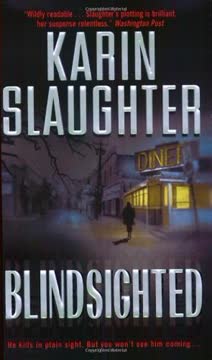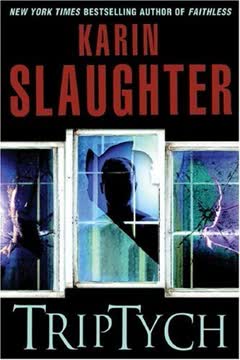Plot Summary
Skating Rink Chaos Unfolds
In the small town of Heartsdale, a seemingly ordinary Saturday night at the local skating rink spirals into chaos when a teenage argument erupts into a deadly shoot-out. Sara Linton, the town's pediatrician and medical examiner, is thrust into the aftermath, discovering that this tragedy is part of a larger, more sinister puzzle. The autopsy reveals shocking evidence of long-term abuse and self-mutilation, setting off a chain of events that will test the town's resolve and uncover hidden darkness.
Secrets and Lies Emerge
As Sara and police chief Jeffrey Tolliver delve deeper into the investigation, they face resistance from the community. The children surrounding the victim, Jenny Weaver, close ranks, and their families refuse to cooperate. The autopsy uncovers evidence of ritualistic abuse, suggesting a web of secrets that extends beyond the immediate tragedy. Sara and Jeffrey must navigate a community unwilling to confront the darkness lurking within, as they strive to piece together the truth.
Unraveling Jenny's Dark Past
The investigation into Jenny Weaver's life reveals a troubled existence marked by abuse and manipulation. Her relationships with peers, particularly Mark Patterson, are scrutinized, revealing a complex dynamic of control and exploitation. As Sara and Jeffrey piece together Jenny's past, they uncover a pattern of behavior that suggests she was a victim of something far more sinister than anyone had imagined, challenging the town to confront its own complicity in her tragedy.
Lena's Struggle with Trauma
Detective Lena Adams, still reeling from her sister's death and her own brutal attack, finds herself drawn into the investigation. Her personal struggles mirror the chaos of the case, as she grapples with her trauma while trying to maintain her professional composure. Lena's interactions with a young man connected to the case hint at answers, but her emotional turmoil threatens to derail her efforts, adding an emotional weight to the investigation.
Investigating the Patterson Family
The investigation turns toward the Patterson family, with Mark Patterson at the center of the storm. His connection to Jenny and the events at the skating rink raise questions about his involvement. As Sara and Jeffrey dig deeper, they uncover a family dynamic fraught with tension and secrets. The Pattersons' reluctance to cooperate only fuels suspicions, complicating the search for the truth and highlighting the complexities of family dynamics.
Lacey's Desperate Escape Attempt
Lacey Patterson, terrified and alone, seeks refuge at Sara Linton's clinic. Her brother Mark, driven by desperation and fear, chases her, leading to a violent confrontation. Lacey's escape is thwarted when she is abducted by a mysterious figure in a black car. This event sets off a frantic search by Sara and the police to uncover the truth behind Lacey's disappearance and the dark secrets of the Patterson family, intensifying the investigation.
Dottie Weaver's Sinister Network
The investigation uncovers a chilling network of child exploitation orchestrated by Dottie Weaver. Her manipulation and control over the children, including Jenny and Mark, reveal a pattern of abuse and coercion. Dottie's ability to evade capture and continue her operations highlights the insidious nature of her crimes. The community is forced to confront the uncomfortable truth about those they trusted, as the investigation takes a darker turn.
Mark's Tragic Confession
Mark Patterson, caught in a web of abuse and manipulation, confesses to Lena Adams about his relationship with his mother, Grace. His admission of being a victim and participant in the exploitation shocks Lena and adds a new layer of complexity to the case. Mark's struggle with his identity and the burden of his past actions lead to a tragic attempt to end his life, leaving the community reeling and questioning their own perceptions.
The Preacher's Dark Secret
Pastor Dave Fine, a respected figure in the community, is revealed to be complicit in Dottie's network. His arrest exposes the depth of the conspiracy and the betrayal of trust within the community. Fine's justification of his actions as acts of love highlights the twisted logic of abusers. His downfall serves as a catalyst for the community to reevaluate their perceptions of morality and faith, as the investigation reaches its climax.
A Community's Hidden Darkness
As the investigation unfolds, the small town of Heartsdale is forced to confront the darkness within its borders. The revelations about Dottie Weaver, Grace Patterson, and Dave Fine challenge the community's moral compass. Sara and Jeffrey's determination to bring justice to the victims is met with resistance, but their perseverance inspires others to face the uncomfortable truths about their neighbors and themselves, leading to a resolution that tests the town's resolve.
Characters
Sara Linton
Sara Linton is the town's pediatrician and medical examiner, thrust into the heart of the investigation following the skating rink tragedy. Her compassion for her patients drives her to uncover the truth behind Jenny Weaver's death. Sara's professional demeanor masks a deep-seated guilt over missed signs of abuse, fueling her determination to bring justice to Jenny and protect other children from similar fates.
Jeffrey Tolliver
As the police chief of Grant County, Jeffrey Tolliver is tasked with unraveling the complex web of secrets surrounding Jenny Weaver's death. His professional resolve is tested by personal connections to the case and his complicated relationship with Sara. Jeffrey's internal struggle with the morality of his actions and the pressure to solve the case adds depth to his character, highlighting the challenges of leadership in a small town.
Lena Adams
Detective Lena Adams is a woman on the edge, grappling with the trauma of her sister's death and her own brutal attack. Her involvement in the investigation is both a professional duty and a personal quest for redemption. Lena's interactions with those connected to the case reveal her vulnerability and strength, as she battles her inner demons while seeking justice for Jenny.
Jenny Weaver
Jenny Weaver is the central figure in the investigation, a young girl whose life was marked by abuse and manipulation. Her death at the skating rink is the catalyst for uncovering a series of dark secrets within the community. Jenny's relationships and the circumstances of her death reveal a complex narrative of victimization and resilience, challenging the town to confront its own complicity in her tragedy.
Mark Patterson
Mark Patterson is a key figure in the investigation, linked to Jenny Weaver through a complicated and troubling relationship. His charm and good looks mask a darker side, as his involvement in Jenny's life raises questions about his role in the events leading up to her death. Mark's interactions with the investigators reveal a young man caught between loyalty and self-preservation.
Dottie Weaver
Dottie Weaver, also known as Wanda Jennings, is the mastermind behind a network of child exploitation. Her ability to manipulate and control those around her, including her own daughter, reveals a chilling disregard for human life. Dottie's evasion of capture and continued operations highlight the insidious nature of her crimes and the challenges faced by those seeking justice.
Lacey Patterson
Lacey Patterson is a young girl thrust into a world of fear and manipulation. Her abduction and subsequent rescue reveal the extent of the abuse she has suffered. Lacey's resilience and bravery in the face of unimaginable horrors highlight her strength, but her future remains uncertain as she grapples with the trauma of her experiences.
Grace Patterson
Grace Patterson is Mark's mother, a woman battling her own health issues while trying to shield her family from scrutiny. Her protective instincts clash with the investigators' need for answers, creating tension and suspicion. Grace's interactions with Sara and Jeffrey reveal a woman torn between loyalty to her family and the fear of what the investigation might uncover.
Teddy Patterson
Teddy Patterson is Mark's father, a man with a history of violence and a deep-seated distrust of authority. His presence looms large over the investigation, as his past actions and current behavior raise questions about his influence on his children. Teddy's interactions with the investigators highlight the complexities of family dynamics and the impact of a father's legacy.
Dave Fine
Pastor Dave Fine is a respected figure whose involvement in the exploitation network shocks the community. His justification of his actions as acts of love highlights the twisted logic of abusers. Fine's arrest and subsequent confession expose the depth of the conspiracy and challenge the community's perceptions of morality and faith.
Plot Devices
Small Town Setting
The small town of Heartsdale serves as a microcosm for the investigation, with its close-knit community and insular nature providing both obstacles and opportunities for the investigators. The setting amplifies the tension and stakes of the investigation, as the town's secrets are slowly uncovered, forcing residents to confront uncomfortable truths about their neighbors and themselves.
Dual Roles of Sara Linton
Sara Linton's dual roles as a pediatrician and medical examiner create a unique dynamic in the investigation, as she balances her professional responsibilities with her personal connections to the case. Her medical expertise provides crucial insights into the evidence, while her compassion for her patients drives her determination to uncover the truth. This duality adds depth to Sara's character and highlights the moral complexities of her role in the investigation.
Lena's Personal Struggles
Lena Adams' personal struggles with trauma and loss mirror the chaos of the investigation, creating a parallel narrative that explores themes of resilience and redemption. Her interactions with the case and the people involved reveal a woman grappling with her own demons while seeking justice for Jenny. Lena's journey adds emotional weight to the investigation and underscores the personal stakes for those involved.
Complex Family Dynamics
The investigation into Jenny Weaver's death is complicated by the complex family dynamics of those involved, particularly the Patterson family. The interplay of loyalty, secrecy, and betrayal within these families creates tension and raises questions about the true nature of the relationships at the heart of the case. These dynamics serve as a driving force in the investigation, challenging the investigators to navigate the tangled web of secrets and lies.
Analysis
"Kisscut" by Karin Slaughter delves into the dark underbelly of a seemingly idyllic small town, exposing the hidden evils lurking within. Through the investigation of Jenny Weaver's death, the novel explores themes of abuse, manipulation, and the complexities of human relationships. The characters' struggles with their own demons and the moral dilemmas they face highlight the challenges of seeking justice in a world where truth is often obscured by secrets and lies. The book serves as a poignant reminder of the importance of confronting uncomfortable truths and the resilience required to overcome the darkness within ourselves and our communities.
Last updated:
FAQ
```markdown
Synopsis & Basic Details
What is Kisscut about?
- Small Town Tragedy Unveiled: Kisscut plunges pediatrician and medical examiner Sara Linton into the dark underbelly of Heartsdale after a deadly shooting at a skating rink. What initially appears to be a singular tragedy quickly unravels into a complex investigation involving long-term child abuse, ritualistic self-mutilation, and a sinister network of exploitation.
- Intertwined Personal and Professional Lives: As Sara and Police Chief Jeffrey Tolliver investigate, they face a wall of silence from the community, forcing them to confront uncomfortable truths about their neighbors and themselves. The case also deeply impacts Detective Lena Adams, who grapples with her own recent trauma while pursuing leads that connect to a wider, more shocking crime.
- Race Against Time for Justice: The abduction of a young girl escalates the urgency, revealing links to the initial death and a pervasive evil. The narrative follows Sara, Jeffrey, and Lena as they race to uncover the deadly secrets hidden by the town's children and their families, hoping to prevent further atrocities.
Why should I read Kisscut?
- Gripping Psychological Depth: Readers should delve into Kisscut for its unflinching exploration of psychological trauma, particularly through Lena Adams's raw and visceral journey of recovery and her unexpected connection to a victim. The novel masterfully portrays the internal battles characters face, making their emotional arcs as compelling as the central mystery.
- Unsettling Social Commentary: Karin Slaughter uses the seemingly idyllic small town of Heartsdale to expose the insidious nature of hidden abuse and the complicity of a community that turns a blind eye. It's a powerful, disturbing look at how evil can fester beneath a veneer of normalcy, prompting readers to question societal assumptions about innocence and protection.
- Masterful Suspense and Character Development: Beyond the shocking plot, the book excels in its intricate character development, especially the evolving, complicated relationship between Sara and Jeffrey. Their personal struggles and moral dilemmas are deeply woven into the fabric of the investigation, adding layers of emotional resonance to a relentlessly suspenseful narrative.
What is the background of Kisscut?
- Southern Small-Town Setting: The novel is set in the fictional Grant County, Georgia, encompassing the towns of Heartsdale, Madison, and Avondale. This rural Southern backdrop is crucial, highlighting the insular nature of small communities where secrets are easily kept and personal histories are deeply intertwined, making the exposure of widespread child abuse even more shocking.
- Focus on Child Exploitation: Kisscut delves into the dark and disturbing world of child pornography and exploitation rings, a theme that was gaining more public awareness around the time of the book's publication (2002). The narrative explores how such networks operate, often preying on vulnerable children and exploiting community trust, using the internet as a tool for connection and distribution.
- Exploration of Trauma and Recovery: A significant background element is the ongoing recovery of Detective Lena Adams from a previous brutal assault (detailed in the preceding novel, Blindsighted). Her physical and psychological scars profoundly influence her perspective and interactions throughout Kisscut, adding a layer of personal stakes and emotional realism to the investigation of child abuse.
What are the most memorable quotes in Kisscut?
- "Shoot me now or I'm gonna shoot him." (Jenny Weaver, Chapter 2): This chilling demand from Jenny Weaver encapsulates her profound despair and the impossible situation Jeffrey faces. It highlights her self-destructive intent and the deep-seated trauma driving her actions, revealing a child pushed to the absolute brink. This quote is pivotal for understanding Jenny's motivations and the tragic climax of the opening scene.
- "I thought I didn't shoot children, either." (Jeffrey Tolliver, Chapter 3): Jeffrey's raw confession to Sara after shooting Jenny reveals the immense psychological toll the event has taken on him. It underscores his internal conflict and the moral ambiguity of his role, challenging the traditional image of a stoic police chief and exposing his vulnerability. This quote is central to Jeffrey's character arc and the themes of guilt and consequence.
- "You're all I got, baby." (Hank Norton, Chapter 9): Spoken by Lena's uncle Hank during a moment of profound vulnerability, this line reveals the deep, complicated bond between them. It highlights Hank's hidden love and fear for Lena, contrasting with his usual gruff demeanor, and underscores Lena's importance as his last remaining family. This quote is crucial for understanding Lena's support system and the emotional undercurrents of her personal journey.
What writing style, narrative choices, and literary techniques does Karin Slaughter use?
- Gritty, Unflinching Realism: Slaughter employs a stark, visceral writing style that doesn't shy away from the brutal realities of violence and trauma. Her descriptions are often graphic, immersing the reader in the harshness of the crimes and their aftermath, which serves to underscore the gravity of the themes explored. This realism is a hallmark of her Grant County series.
- Alternating Perspectives and Deep POV: The narrative frequently shifts between the perspectives of Sara Linton, Jeffrey Tolliver, and Lena Adams, often delving deep into their internal thoughts and emotional states (deep point of view). This choice allows readers to experience the psychological impact of the investigation from multiple angles, building empathy and revealing the characters' complex inner lives and unspoken motivations.
- Foreshadowing and Symbolic Imagery: Slaughter masterfully uses subtle foreshadowing and recurring symbolic imagery to weave deeper meaning into the plot. For instance, environmental descriptions often mirror character states (e.g., oppressive heat reflecting emotional turmoil), and recurring motifs like scars or specific objects carry significant symbolic weight, enriching the reader's interpretive experience.
Hidden Details & Subtle Connections
What are some minor details that add significant meaning?
- Jeffrey's Childhood Room: The description of Jeffrey's boyhood room (Chapter 8), unchanged since he left for Auburn, with his football jersey, old Playboys, and a poster of a Mustang, subtly reveals his deep-seated desire for escape and to be different from his criminal father. This detail highlights his lifelong struggle against his past and his yearning for a simpler, freer existence, contrasting sharply with the burdens of his current role.
- Lena's Scars and Physical Sensations: Lena's constant awareness of her scars and the physical sensations of pain (e.g., slamming her fingers in a car door, Chapter 4) are not just reminders of her trauma but also a perverse form of connection to feeling alive. This detail underscores her profound dissociation and the desperate search for sensation, revealing the depth of her psychological damage and her struggle to reclaim her body and mind.
- The "Purity" Motif: Jenny Weaver's desire to make her body "pure" (Chapter 5) and the subsequent revelation of the female genital mutilation, combined with the pedophile network's twisted concept of "pure" children (Chapter 8), creates a chilling thematic echo. This seemingly minor detail from Dottie Weaver's interview becomes a central, horrifying motif, exposing the perversion of innocence and the abusers' self-justifying ideology.
What are some subtle foreshadowing and callbacks?
- Jenny's Backpack and Sara's Bloodstain (Chapter 1): The seemingly innocuous detail of Jenny Weaver's dark red backpack brushing against Sara, leaving a "narrow streak of blood," is a subtle yet potent foreshadowing of the violence and trauma Sara is about to uncover. It immediately links Jenny to a hidden injury and foreshadows Sara's direct, visceral involvement in the case, literally marking her with the victim's pain.
- Lena's Reaction to Hank's Touch (Chapter 4): Lena's violent reaction to Hank's paternal touch, perceiving it as a "sickening reminder of the way he had touched her before," subtly foreshadows the later revelation of Mark Patterson's incestuous relationship with his mother. This callback to Lena's own trauma highlights the insidious nature of abuse and the lasting psychological impact of inappropriate touch, creating a parallel between Lena's past and the victims' experiences.
- Teddy Patterson's Distrust of Police (Chapter 7): Teddy Patterson's deep-seated distrust of the police, stemming from his own criminal past, is repeatedly emphasized. This detail subtly foreshadows his willingness to leave Mark alone with Lena and Jeffrey, effectively abandoning his son to the authorities. It callbacks to his own experiences with law enforcement and reveals a self-serving pragmatism that prioritizes his own freedom over his children's well-being.
What are some unexpected character connections?
- Sara and Lacey's Shared Vulnerability: An unexpected connection emerges between Sara and Lacey Patterson, as Lacey seeks Sara out at the clinic, trusting her implicitly. This bond is deepened by Sara's own inability to have children and her deep empathy for vulnerable youth, creating a maternal connection that transcends their professional roles. This connection highlights Sara's profound sense of responsibility and her personal investment in protecting children.
- Lena and Mark's Shared Trauma: The most unexpected and disturbing connection is between Lena Adams and Mark Patterson. Mark's confession of abuse and his suicidal ideation resonate deeply with Lena's own experiences of rape and suicidal thoughts. Their shared understanding of profound pain and violation creates a raw, unsettling intimacy during their interview, revealing a mirrored psychological landscape that Lena struggles to process. This connection is crucial for understanding Mark's motivations and Lena's evolving recovery.
- Dottie Weaver and Grace Patterson's Criminal Partnership: The revelation that Dottie Weaver (Wanda Jennings) and Grace Patterson were not just acquaintances but long-standing partners in the child exploitation ring is a shocking twist. Their connection, rooted in a shared history of abuse and a twisted sense of "purity," reveals a deeply disturbing female-led criminal enterprise. This unexpected alliance subverts typical gender roles in crime narratives and underscores the pervasive nature of evil.
Who are the most significant supporting characters?
- Hank Norton: Lena's uncle, Hank, is a pivotal supporting character whose gruff exterior hides a deep, complicated love for Lena. His struggles with addiction and his attempts to guide Lena, despite his own flaws, provide a crucial emotional anchor for her. Hank's unwavering presence, even when Lena pushes him away, highlights themes of family loyalty and the messy reality of support systems. His actions, like removing Lena's bedroom door, are extreme but born of genuine concern, driving Lena's reluctant path toward healing.
- Molly Stoddard: Sara's nurse, Molly, serves as a grounded, pragmatic confidante and a voice of reason. Her unwavering support for Sara, coupled with her realistic perspective on the challenges of their profession, provides a vital counterpoint to Sara's often overwhelming guilt and idealism. Molly's presence underscores the importance of professional solidarity and the emotional toll of working with traumatized children, offering Sara both practical assistance and emotional validation.
- Nick Shelton: The GBI field agent, Nick Shelton, is a crucial ally in the investigation, providing external resources and expertise. His dry wit and professional competence offer moments of levity and efficiency amidst the grim discoveries. Nick's role highlights the broader scope of child exploitation networks and the collaborative effort required to dismantle them, connecting the local tragedy to a wider criminal landscape.
Psychological, Emotional, & Relational Analysis
What are some unspoken motivations of the characters?
- Jeffrey's Need for Control and Redemption: Beneath Jeffrey's stoic exterior lies an unspoken motivation to control situations and redeem himself, particularly after his past infidelity and the trauma of shooting Jenny. His desire to "not fuck it up" with Sara (Chapter 8) and his intense focus on solving the case are driven by a deep-seated need to prove his worth and regain a sense of moral authority, both personally and professionally.
- Lena's Pursuit of Self-Punishment and Validation: Lena's relentless drive in the investigation, her willingness to push boundaries, and her initial reticence to confirm Jeffrey's "clean shot" (Chapter 7) are subtly motivated by a desire for self-punishment and a search for validation. Her trauma has left her feeling "compromised" and "powerless," and by confronting the darkest aspects of human nature, she unconsciously seeks to reclaim control and prove her strength, even if it means inflicting pain on herself or others.
- Dottie Weaver's Twisted Sense of Power and Legacy: Dottie's motivations extend beyond mere financial gain; her actions are driven by a deeply twisted sense of power and a desire to perpetuate a cycle of abuse, perhaps stemming from her own past. Her "triumphant smile" when discussing her ex-husband's failure (Chapter 5) and her calculated manipulation of children suggest a need to exert absolute control and leave a perverse legacy, using "purity" as a justification for her horrific acts.
What psychological complexities do the characters exhibit?
- Sara's Empathic Overload and Guilt: Sara exhibits profound psychological complexity through her empathic overload, where the suffering of her patients deeply affects her, leading to intense guilt over perceived failures. Her inability to have children amplifies this, making her feel a heightened responsibility for every child she encounters. This internal struggle between her professional detachment and personal anguish highlights the emotional cost of her dual roles as pediatrician and medical examiner.
- Jeffrey's Moral Injury and Disillusionment: Jeffrey grapples with moral injury, particularly after being forced to shoot Jenny Weaver. This event shatters his sense of self as a protector, leading to profound disillusionment and self-doubt. His struggle to reconcile his actions with his moral compass, coupled with the emotional distance he sometimes creates, reveals the psychological burden of leadership and the corrosive nature of violence on the human psyche.
- Lena's Dissociation and Search for Identity: Lena's psychological state is marked by dissociation, a coping mechanism developed after her rape. She struggles with fragmented memories, a distorted sense of self, and a desperate need to feel "real" again. Her journey is a complex search for identity, where she oscillates between numbness and intense emotion, often finding a perverse comfort in pain or a sense of control in confronting evil, reflecting the profound psychological impact of severe trauma.
What are the major emotional turning points?
- Jeffrey's Shooting of Jenny Weaver (Chapter 2): This is a monumental emotional turning point for Jeffrey, shattering his self-perception as a non-lethal officer. The act of taking a child's life, even under duress, plunges him into profound guilt and self-doubt, fundamentally altering his emotional landscape and his relationship with Sara. It forces him to confront the brutal realities of his job in a deeply personal way.
- Lena's Confrontation with Sara (Chapter 6): Sara's accusation, "Now you know what it's like to hurt somebody," deeply wounds Lena, triggering a raw emotional response. This moment is a turning point for Lena, as it forces her to confront her own capacity for inflicting pain and the complex emotions surrounding her trauma, pushing her further into isolation but also fueling her determination to understand the victims.
- Mark's Confession to Lena (Chapter 12): Mark's tearful confession of his abuse by his mother and his own subsequent actions is a critical emotional turning point, particularly for Lena. It creates an unexpected, unsettling bond between them, as Lena recognizes a shared experience of violation and powerlessness. This moment humanizes Mark for Lena, challenging her black-and-white view of victims and perpetrators, and profoundly impacting her own healing process.
How do relationship dynamics evolve?
- Sara and Jeffrey's Rekindled, Tested Romance: Their relationship evolves from a tentative, post-divorce dating phase into a deeper, more committed bond forged through shared trauma. Jeffrey's vulnerability after shooting Jenny and Sara's unwavering support, despite her own pain, push them past their previous issues. Their decision to "try again" and Sara's willingness to "wake me" (Chapter 14) for him signifies a renewed commitment, tested by the horrors they face together.
- Lena and Hank's Complicated Interdependency: The dynamic between Lena and her uncle Hank shifts from one of strained obligation and resentment to a fragile, yet profound, interdependency. Hank's forceful interventions (e.g., removing her door, making her run) are initially met with anger, but his raw admission, "You're all I got, baby" (Chapter 9), reveals his deep love and fear. Lena's eventual acceptance of his presence, even as she struggles for independence, shows a softening of her defenses and a recognition of their mutual need.
- Mark and Lacey's Abusive Sibling Bond: The relationship between Mark and Lacey Patterson is revealed to be a deeply twisted and abusive one, manipulated by their mother. What appears to be a protective sibling bond is exposed as a cycle of exploitation and complicity. Mark's initial "protection" of Lacey from external threats is tragically contrasted with his own role in her abuse, highlighting the devastating impact of their family's dark secrets on their sibling dynamic.
Interpretation & Debate
Which parts of the story remain ambiguous or open-ended?
- Lacey Patterson's Long-Term Recovery: While Lacey is rescued, the story leaves her long-term psychological and emotional recovery ambiguous. The extent of her trauma, her capacity to process the abuse, and her future well-being are left open-ended. Sara's observation that Lacey "no longer looked like a carefree little girl... aged by circumstance" (Chapter 22) underscores the lasting impact, leaving readers to ponder the true cost of her survival.
- The Full Extent of the Exploitation Network: Although Dottie Weaver and Dave Fine are identified as key players, the novel hints at a much larger, more sophisticated child exploitation network. The "phone network" (Chapter 15) and the "big guys" (Chapter 11) suggest that many more individuals and locations are involved, leaving the full scope of the operation and the fate of other potential victims unresolved. This ambiguity emphasizes the pervasive and elusive nature of such crimes.
- Jeffrey's Internalized Guilt and Moral Compass: Despite Paul Jennings's and Sara's reassurances that Jeffrey "did the right thing" (Chapter 15, 20) in shooting Jenny, Jeffrey's internal struggle with guilt remains open-ended. His final thought, "He did not believe her" (Chapter 20), indicates that he may never fully reconcile his actions with his moral compass. This ambiguity challenges readers to consider the lasting psychological scars of difficult decisions and the subjective nature of "right" and "wrong" in extreme circumstances.
What are some debatable, controversial scenes or moments in Kisscut?
- Jeffrey's Decision to Shoot Jenny Weaver: The most controversial moment is Jeffrey's split-second decision to shoot thirteen-year-old Jenny Weaver. While presented as a necessary act to save Mark Patterson, the scene forces readers to grapple with the morality of a police chief killing a child, even one holding a gun. The debate centers on whether there could have been another way, and the profound ethical implications of such a choice, especially given Jenny's own victimhood.
- Lena's Interrogation Tactics with Dottie Weaver: Lena's aggressive and emotionally manipulative interrogation of Dottie Weaver, including showing her graphic autopsy photos of Jenny, is highly debatable. While effective in breaking Dottie's composure and extracting information, it raises questions about ethical police procedure and the line between justice and cruelty, especially towards a grieving mother (even if she is a perpetrator). This scene highlights Lena's own trauma influencing her methods.
- Mark Patterson's Confession of Incest and Enjoyment: Mark's confession to Lena about his incestuous relationship with his mother, and his disturbing admission that "it felt so good" (Chapter 12), is deeply controversial. This moment challenges readers to confront the complexities of abuse, where victims can also become perpetrators, and the unsettling reality that pleasure can be intertwined with profound violation. It sparks debate about the nature of consent, the psychological impact of trauma, and the blurred lines of victimhood.
Kisscut Ending Explained: How It Ends & What It Means
- Dottie Weaver's Escape and Continued Threat: The novel concludes with Dottie Weaver (Wanda Jennings) successfully evading capture, having used a decoy (Ross Davis) to retrieve her mail and credit cards. She escapes in a black Thunderbird, leaving Jeffrey and Sara to realize she is "out there, Sara. She's out there doing this again" (Chapter 22). This ending signifies the insidious nature of child exploitation, suggesting that evil often persists and that justice is not always absolute or immediate. It leaves a lingering sense of dread and the understanding that the fight against such crimes is ongoing.
- Lacey Patterson's Rescue and Uncertain Future: Lacey Patterson is rescued from a hidden
Review Summary
Kisscut is a disturbing and intense thriller that tackles difficult topics like child abuse and pedophilia. Many readers found it compelling but emotionally challenging. The characters, especially Sara and Jeffrey, continue to develop interestingly. While some appreciated Slaughter's unflinching approach to dark subject matter, others felt certain plot elements were unnecessarily graphic. Overall, reviewers praised the gripping mystery and Slaughter's skilled writing, though they emphasized the need for trigger warnings due to the book's disturbing content.
Grant County Series
Similar Books
Download PDF
Download EPUB
.epub digital book format is ideal for reading ebooks on phones, tablets, and e-readers.























